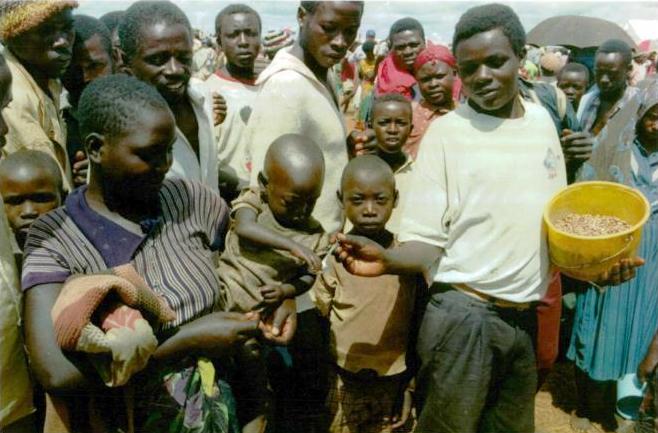
20th Century African Refugees: Country Trends--Tanzania

Figure 1.-- Tanzania has been a save have fir refugees fleeig the Great Lakes region. The press caption read, "A Rwandan child gets a spoonful of beans at the Benaco Refugee Camp in Tanzania, Thursday May 26, 1994. Hundreds of thousands of Rwandans have fled the blood bath in their country and cmped at Benaco at Tanzanian border." Photograher: B.K. Bangash.
|
|
Tanzania has offered a haven for reugees even before becoming independent (1961). The country has been a force for stability in East Africa. It birders on many troubkled countries which people have fled to escape viloence resulting from civil war, genocide, economic failure, and tribal conflict. The country helpe srabilize the region hen it united with troubled Zanzibr. From an early point refugees from bordering countries (Uganda, Rwanda, Burundi, Congo, Mozambique) as wll as the Comoro Islnds and Somalia. The largest number of refugees have come from Burundi which like Rwanda has been racked by tribal conflict. The first wave of asylum seekers camne from Rwanda (1959). Tanzania had at that time an open door policy towards refugees. A massive wave of refugees arrived from Burundi (1972). Terrible tribal killings there mounted to a 'selective genocide. [Minority Rights Group]. Some 160,000 Burundian refugees crissed the border into Tanzania. Many have been naturalized instead of retuning to Burundi. Uganda refugees fleeing the Ifi Amin regime sought refugee in Tanzania and organized a resistace movement. When Amin invaded Tanzania, the Tanzanian Army struck back aiuded by Ugandan residrance fighters and overthrew Amin (1978-79). Most of the Ugandan refugees with Amin gone returned to their country. Rwanda refugees were settled in Ngara villages (1989). The Islamic violence in Somalia drove thousands of refugees to Tanzania (1990-91). Many settled in Dar Es Sam,em without permission. Even more Burundins, some 300,000 fled acrodss the border when a civil war erupted (1993). The Tanzania Government reported an estimated 1 million refugees in the country (2000). The vast majority canme from the Great Lakes region. The overwhelming majority came from Burundi (nearly 70 percent). [Roos, 2005.] This is in part because of genocidal violence in Rwanda and Burundi and in part because many ealier refugees have become naturalized. A million refugees is a masive drain on resources for a reklstively poor country like Tanzania. The Government currently is attempting the end the refugee situation in the country. Refugees are being encouraged to live in the two remaining refugee camps (Nyarugusu and Mtabila). Those who are unwilling to return to their country are mostly self settling in Dar Es Salaam.
Sources
Minority Rights Group.
Willems, Roos (2005), "Coping with displacement: Social Networking among Refugees," in Ohta Itaru and Yntiso D. Gebre (eds.) Displacement Risks in Africa: Refugees, Resettlers and their Host Populations (Trans Pacific Press, Australia: 2005), pp. 53-77.
CIH

Navigate the Children in History Website:
[Return to Main 20th century African country refugee page ]
[Return to Main 20th century African refugee page]
[Return to Main 20th century refugee groups]
[Return to Main specific refugee groups]
[Return to Main refugee page]
[Return to Main children and war page]
[Return to Main war essay page]
[Introduction]
[Biographies]
[Chronology]
[Climatology]
[Clothing]
[Disease and Health]
[Economics]
[Geography]
[History]
[Human Nature]
[Law]
[Nationalism]
[Presidents]
[Religion]
[Royalty]
[Science]
[Social Class]
[Bibliographies]
[Contributions]
[FAQs]
[Glossaries]
[Images]
[Links]
[Registration]
[Tools]
[Children in History Home]
Created: 1:06 PM 10/30/2018
Last updated: 1:06 PM 10/30/2018



